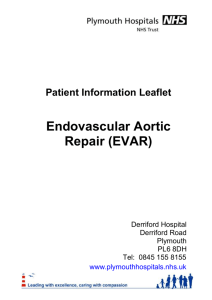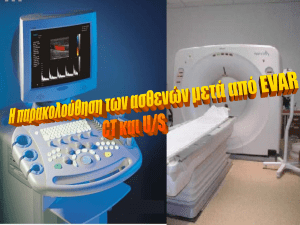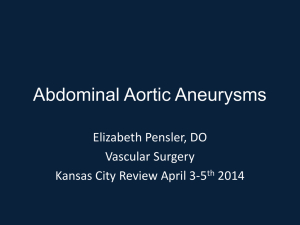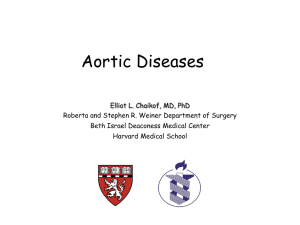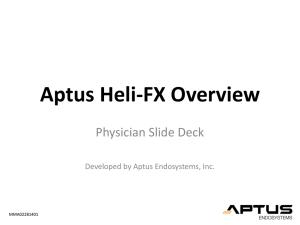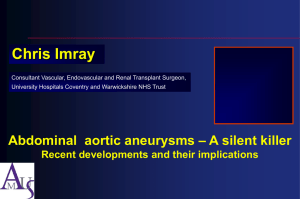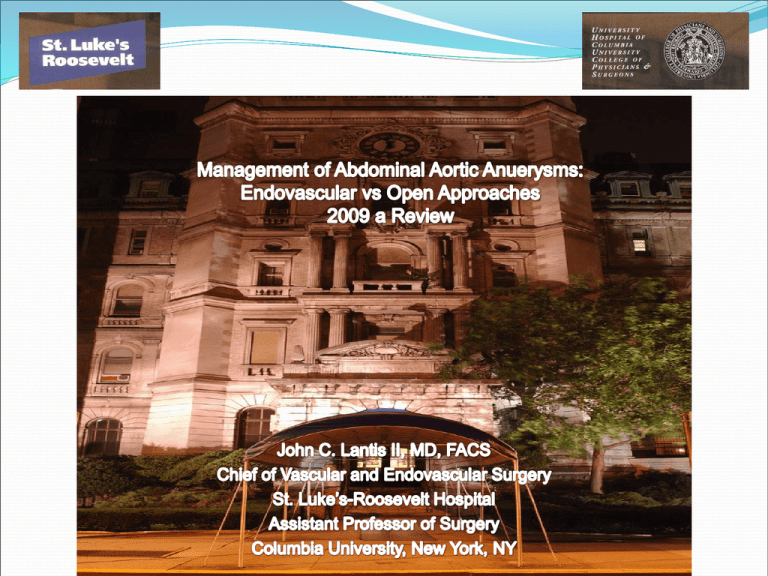
Epidemiology
Age:
5-7% of population 60+yrs age
US: reported incidence of 5-7%
Mean age 70-75yrs
Sex:
M:F = 1.6-4.5:1
Race:
White M > Blacks M
White F = Black F
Mortality/Morbidity:
Grows ~0.4 cm/year
75% mortality (upon rupture)
13th leading cause of death in the US (~15,000 deaths per year)
Overall mortality 0.9%-5% after repair
Rupture is based on size
Pathophysiology & Risk Factors
Atherosclerosis
Elastin
Wall Structure
Genetics
Smoking
Brady AR, Thompson SG, Greenhalgh RM, et al. Br J
Surg 90:492, 2003.
90% had smoking history
Others: HTN, infection, trauma, arteritis, cystic
medial necrosis, Marfan Syndrome, Ehlers-Danlos
Syndrome
Symptoms and Signs
Asymptomatic
Inflammatory AAA may cause back pain
Pulsatile abdominal mass
Mid-abdomen just above and left of the umbilicus
Lederle FA, Wilson SE, Johnson GR, et al. N Engl J Med
346:1437, 2002.
Ruptured AAA
Triad (50%):
1.
2.
3.
Sudden onset abdominal pain
Pulsatile mass
Hypotension
Imaging
Incidental, ultrasound, CT angiogram
and angiogram
Diagnosis
Physical exam
◦
◦
Firm, pulsatile abdominal mass
Overall sensitivity of 52%
◦
Extension into iliac arteries is not appreciated
X-ray
◦
◦
◦
◦
Sensitivity increases with diameter
29% for 3.0 to 3.9cm
50% for 4.0-4.9 cm
76% for > 5.0 cm
About 70% of cases
Characteristic eggshell pattern of calcification
Accurate determination of size difficult
Negative AXR does NOT rule out diagnosis
Ultrasound
◦
◦
◦
◦
Most widely used noninvasive test
Provides structural detail of vessel wall
Can accurately measure the size in longitudinal and
cross sectional directions
Advantages
Noninvasive, low cost, wide availability
Good for initial evaluation or pts, screening and
surveillance
Diagnosis
CT
◦
◦
Most precise test for imaging AAA
Can identify
Proximal and distal extent of
aneurysm, including thoracic portion
Occlusive aneurysmal disease
Presence of multiple and accessory
renal arteries
Seize of aortic lumen, amount of
thrombus, and presence of calcific
disease
MRI
◦ Imaging of choice for patients with renal
insufficiency
◦ High quality images of aorta
◦ However, less sensitive in identifying
accessory renal arteries or renal artery
stenosis
Arteriography
◦ Reliable information on size of aortic
lumen and branch vessel disease
◦ However, due to thrombus, aortic lumen is
near normal in size so inaccurate
assessment of size or aneurysm
◦ Helpful for assessment of associated
arterial disease in pre-op eval
Screening
SVMB/SVS/AAVS (2004)
Kent KC, Zwolak RM et al: Screening for abdominal aortic aneurysm: a consensus statement. J
Vasc Surg 39(1):267, 2004
Men: Recommends for screening in all men age 60-85 years
Women: Recommends for screening in women age 60-85 years with a family history of AAA
USPSTF (2005)
Men: Recommends for screening in men age 65-75 years who have ever smoked. Recommends
against screening in men age 65-75 years who have never smoked
Women: Recommends against screening in all women
ACC/AHA (2006)
Men: Recommends for screening in men age 65 years or older who have ever smoked.
Recommends for screening in men age 60 or older with a family history of AAA
Women: None
Screening for Aneurysms
4 randomized trials of AAA screening have been performed
◦ Reduction in AAA related mortality ranging from 21-68%
◦ Reduction in AAA rupture ranging from 45-49%
Multicentre Aneurysm Screening Study
◦ >70,000 men screened between ages of 65-74
◦ Aneurysms >5.5 cm referred for repair
◦ After 4 years there was 42% reduction in AAA related deaths in
the screened group
Society for Vascular Surgery screening recommendations
◦ Baseline ultrasound screening for AAA in
Men 60-85
Women 60-85 with cardiovascular risk factors
Men and women older than 50 with a family history of AAA
◦ Yearly ultrasound for AAA 4.0-4.5cm
◦ Ultrasound every 6 months for AAA larger than 4.5cm
AAA Expansion and Rupture
Average growth rate: ~0.4cm per year
Factors: BP, size at detection, COPD
Size is the best determinant of rupture
40% of untreated aneurysms 5.5-6cm or larger will
rupture within 5 years
Average survival without treatment: 17 months
Lederle FA et al. JAMA 2002;287:2968.
Rupture Repair – EVAR is superior
30 day mortality
EVAR 19%, Open 47%
LOS
EVAR 6, Open 18.5
D/C to home
EVAR 55%, open 20%
Major complication
EVAR 36%, Open 80%
OR time
EVAR 3 hours, Open 4.5 hours
Blood loss
EVAR 200 cc, Open 4 liters
Treatment
Joint Council of the American Association for Vascular Surgery and Society for
Vascular Surgery (Brewster DC, Cronenwett JL, Hallett JW, et al. Vasc Surg 37:1106,
2003)
1. The arbitrary setting of a single threshold diameter for elective AAA repair that is
applicable to all patients is not appropriate, as the decision for repair must be
individualized in each case.
2. Randomized trials have shown that the risk of rupture of small (<5 cm) AAAs is quite low
and that a policy of careful surveillance up to a diameter of 5.5 cm is safe, unless rapid
expansion (>1 cm/y) or symptoms develop. However, early surgery is comparable to
surveillance with later surgery, so patient preference is important, especially for AAAs 4.5
to 5.5 cm in diameter.
3. Based upon the best available current evidence, a diameter of 5.5 cm appears to be an
appropriate threshold for repair in an "average" patient. However, subsets of younger,
low-risk patients with long projected life expectancy may prefer early repair. If the
surgeon's personal documented operative mortality rate is low, repair may be indicated at
smaller sizes (4.5 to 5.5 cm) if that is the patient's preference.
4. For women, or AAAs with greater-than-average rupture risk, 4.5 to 5.0 cm is an
appropriate threshold for elective repair.
5. For high-risk patients, delay in repair until larger diameter is warranted, especially if
endovascular aortic repair (EVAR) is not possible.
6. In view of its uncertain long-term durability and effectiveness, as well as the increased
surveillance burden, EVAR is most appropriate for patients at increased risk for
conventional open aneurysm repair.
7. EVAR may be the preferred treatment method if anatomy is appropriate for older, highrisk patients, those with "hostile" abdomens, or other clinical circumstances likely to
increase the risk of conventional open repair.
8. Use of EVAR in patients with unsuitable anatomy markedly increases the risk of adverse
outcomes, the need for conversion to open repair, or AAA rupture.
9. At present, there does not appear to be any justification that EVAR should change the
accepted size thresholds for intervention in most patients.
10. In choosing between open repair and EVAR, patient preference is of great importance. It
is essential that the patients be well informed to make such choices.
Surgery
Open repair with synthetic graft
35% of current cases
Primarily for poor anatomy
Ocassionally young age
Endovascular aneurysm repair
(EVAR)
65% of current cases
Anatomic Requirements for EVAR
Anatomic Criteria
Length, angulation, and diameter of infrarenal neck
> 60° neck angulation – 70% complication rate
Minimum adequate length is 8 mm
Desireable length is 1.5 cm
Iliac artery diameter
Large enough to accommodate device (7 mm)
Small enough to allow device to seal (1.5 cm)
Concurrent common or internal iliac artery aneurysm
Can be difficult to manage
Absence of thrombus at aortic neck
Thrombus does not allow for a good neck seal
Standard Open Repair
Complications of Open Repair
Mortality rate less than 5% in good risk pts
◦ Most frequent cause of death is ischemic myocardial injury
Complications following elective open repair occur in 10-30% of cases
◦ Most frequent complication is nonfatal MI (avg. 6.9%) usually within first
◦
◦
◦
◦
◦
◦
◦
◦
◦
48 hours post-op
Renal failure (6%)
Pneumonia (5%)
Bleeding
Ileus
Ischemia of left colon and rectum
Lower extremity ischemia from embolization of thrombus or
atherosclerotic plaque
Ischemic injury to lumbosacral plexus or to the spinal cord
Post-op sexual dysfunction from injury to autonomic nerves during
dissection (up to 25% of patients)
DVT in as many as 18% of patients
Complications of Open Repair
Late complications after successful repair are rare
◦ Only occurs in about 7% of patients, but Late
complications more common in repair of rupture (17%)
◦ Complications include:
Anastomic pseudoaneurysm (3%)
Graft thrombosis (2%)
Graft-enteric erosion or fistula (1.6%)
Graft infection (1.3%)
Anastomotic hemorrhage (1.3%)
Colonic ischemia (0.7%)
Atheroembolism (0.3%)
Endovascular Aneurysm Repair (EVAR)
Potential Drawbacks of EVAR
Need for frequent CT scans/follow up
1 month, 3 months, 6 months, one year and every year
thereafter
90 % efficacious at 6 year mark
Need for conversion
Late rupture rate
Up to 25% of patients need reintervention within the
first year
Complication of EVAR: Endoleaks
Type I: Lack of complete seal between stent graft
and vessel wall at attachment sites
Type II: Back filling of the aneurysm sac via such
branch vessels as the lumbar of inferior mesenteric
arteries
Type III: Leaks at connections of modular
components, device disruption, fabric tears
Type IV: Extravasation of contrast material
through interstices in the grafted artery
White GH, May J, Waugh RC, et al. J Endovasc Surg 1998;5:189–193.
Open vs. EVAR
Follow
30d
up (yrs) Mortality
Total
Death
Study
Patients
Mayo Clinic AAA
(Open)
307
36
5
7.6
Canadian AAA
(Open)
680
6
5.4
5.8
AneuRx I–III
(EVAR)
1192
4
1.9
2.4
EUROSTAR
(EVAR)
2955
4
1.7
2.5
St Luke’s- Roosevelt Last Evaluated 124 case –
Endoleak and rate and aneurysm follow up data
Time 0
1 mo.
6 mo.
1 year
2 years
3 years
Persistent
endoleak
rate
21%
5.9%
7.5%
10.1%
8.5%
8.5%
New
endoleak
rate
-
5.9%
4.3%
2.5%
2.8%
2.8%
Total
endoleak
rate
21%
11.8%
11.8%
12.6%
11.4%
11.4%
Migration
rate
-
4%
1.0%
1.2%
1.4%
0%
5.3 cm
5.1 cm
4.8 cm
4.5 cm
.83%
2.0%
0%
2.8%
Aortic size
Reinterventi
on rates
5.4 cm
-
4.0 cm
0%
Trials
EVAR (Greenlagh, R)
DREAM (Blankensteijn, J)
ACE (Becquemin, J)
OVER (Lederle, F)
DREAM (Dutch Randomized Endovascular
Aneurysm Management)
Prinssen M, Verhoeven EL, Buth J, et al. N Engl J Med
2004;351:1607–1618.
Open vs. EVAR
Radomized controlled trial of 345 patients with AAA >5cm
EVAR operative mortality 1.2%
Open repair operative mortality 4.6%
Blankensteijn JD, de Jong SE, Prinssen M, et al. N Engl J
Med 2005;352:2398–2405.
Evaluation of perioperative period
Cumulative survival rate were similar (89.6% vs. 89.7%)
EVAR had lower aneurysm-related death (2.1% vs. 5.7%)
Dutch Randomized Endovascular
Management Trial (DREAM)
30 day mortality was better in EVAR group (1.2% vs..
4.6%)
EVAR group showed less operative mortality and postop complications (4.7% vs.. 9.8%)
No overall survival difference at 2 years
Aneurysm related death less in EVAR group (2.1% vs..
5.7%)
Endovascular Aneurysm Repair Trial -1 (EVAR-1)
Short term survival benefit of EVAR
30 day mortality rate 1.7% vs.. 4.7%
At 4 years, no difference in mortality
Aneurysm related death less in EVAR group (4% vs.. 7%)
Greater post-op complications over 4 year follow-up in
the EVAR group (41% vs. 9%)
No difference in quality of life
Hospital costs higher in EVAR group
EVAR-2 Trial
Looked at effectiveness of EVAR in high risk patients
Compared EVAR to observation
No benefit of EVAR over observation
30 day mortality rate after EVAR was 9%
4 year mortality rate in EVAR group 64%
No difference in late overall mortality
No difference in aneurysm related mortality
Higher hospital costs in EVAR group
No health-related quality of life benefit to EVAR
Where are we going next?
Suprarenal fixation
Including renal stent grafts
Branched grafts
Including visceral artery stent graft
More skills?
Less access?
More cost?
More morbidity?
Questions?

